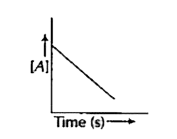How would you account for the following?
(a) Transition metals exhibit variable oxidation states.
(b) Zr(Z = 40) and Hf (Z = 72) have almost identical radii.Solution in Odia
(a) ns and (n-1) d-electrons of transition metals participate in bonding, which results in various oxidation states. When ns-electrons take part in bonding, they exhibit lower oxidation states, whereas when (n-1) d-electrons along with ns-electrons participate in bonding, they exhibit higher oxidation states.
(b) Due to lanthanide contraction, the atomic radii of 4d and 5d transition series elements are almost same. That.s why, Zr (Z = 40) and Hf (Z =72) have almost identical radii.
Topper's Solved these Questions
- SAMPLE PAPER 1 BOOK - ARIHANT PUBLICATIONCHAPTER - SAMPLE PAPER 1 EXERCISE - GROUP C
14 Videos
- SAMPLE PAPER 1 BOOK - ARIHANT PUBLICATIONCHAPTER - SAMPLE PAPER 1 EXERCISE - GROUP A
7 Videos
- QUESTION PAPER 2019BOOK - ARIHANT PUBLICATIONCHAPTER - QUESTION PAPER 2019EXERCISE - GROUP C
11 Videos
- SAMPLE PAPER 4 BOOK - ARIHANT PUBLICATIONCHAPTER - SAMPLE PAPER 4 EXERCISE - GROUP C
7 Videos
Similar Questions
A strip of nickel metal is dipped in a 1 molar solution of Ni(NO3)2 and a strip of silver metal is dipped in a 1 molar solution of AgNO3. An electrochemical cell is created when the two solutions are joined by salt bridge and two strips are joined by wire to a voltmeter.
Answer the following questions.
Write the balanced equation for the overall cell reaction and calculate the cell potential.
View SolutionWhich noble gas is used in atomic reactor ?
View SolutionWhat are oil in water and water in oil type of emulsions ? Give one example of cach type.
View SolutionConsider the reaction, Ak−−→P. The change in the concentration of A with time is shown in the following plot:

(a) Derive the expression for the time required for the completion of the reaction.
(b) Predict the order of the reaction.
View SolutionHow would you account for the following?
(i) Transition metals exhibits variable oxidation state.
(ii) Zr(Z=40) and Hf(Z=72) have almost identical radii.
(iii) Transition metals and their compounds act as catalyst.
OR
Complete the following chemical equation:
(i)Cr2O2−7+6Fe2++14H+→
(ii) CrO2−4+2H+→
(iii) 2MnO2−4+5C2O2−4+16H+→
View SolutionZr(Z=40) and Hf(Z=72) have similar atomic and ionic radii because of:
View SolutionHow would you account for the following? (l) Transition metals exhibit variable oxidation states. (ii) Zr (Z = 40) and Hf (Z = 72) have almost identical radii. (iii) Transition metals and their compounds act as catalyst.
View SolutionZr and Hf have almost identical atomic radii. Give reason.
View SolutionGive reasons:
Zr and Hf have almost identical radii.
View SolutionCompare atomic radii of Zr (Z = 40) and Hf (Z = 72).
View SolutionWhy do Zr(Z = 40) and Hf(Z = 72) have comparable atomic radii ?
View SolutionWhy do Zr and Hf exhibits similar properties?
Why do transition metal show variable oxidation states.
View SolutionZr and Hf have almost identical atomic radii. Give reason?
View SolutionHow will you accout for the following ?
(i) Actinoids exhibit more number of oxidation states than lanthanoids.
(ii) Atomic radii of second and third transition series elements are almost identical.
View SolutionHow will you account for the following: (a) Actinoids exhibit more number of oxidation states than lanthanoids. (b) Atomic radii of second and third transition series elements are almost identical.
View SolutionZr and Hf have almost identical atomic radii. Give reason?
View Solution
